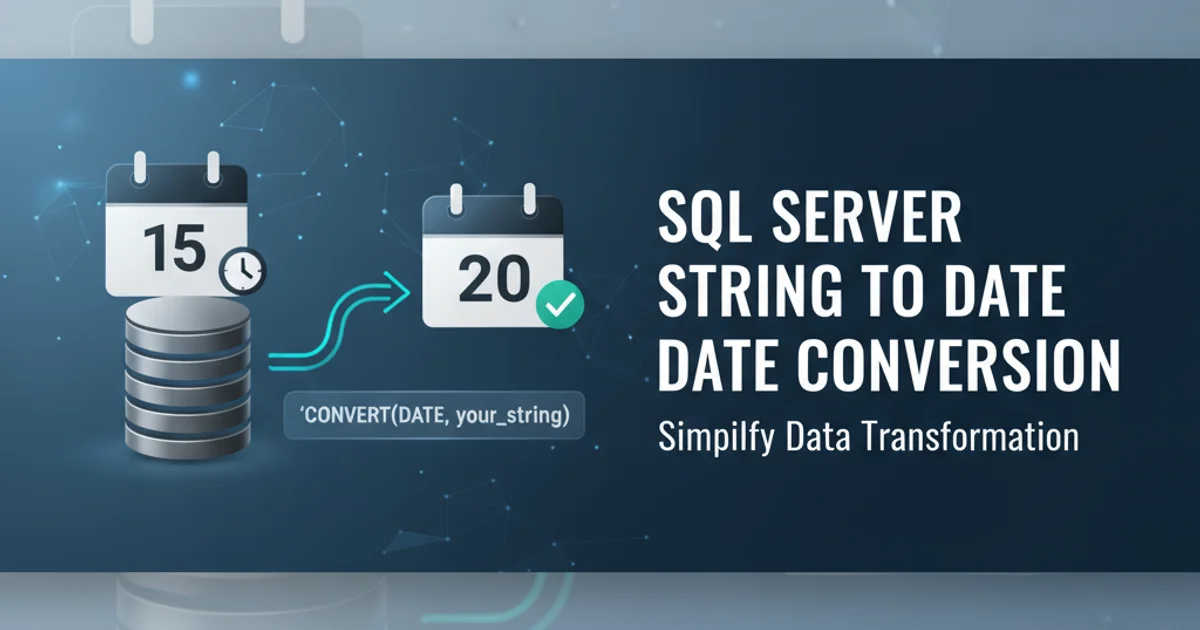Sql connection-string for localhost server
Categories:
Crafting SQL Connection Strings for Localhost Servers

Learn how to construct robust SQL connection strings for local development environments, covering common scenarios and best practices for SQL Server Express.
Connecting to a local SQL Server instance is a fundamental task for developers. Whether you're using SQL Server Express for development or a full SQL Server installation on your machine, understanding the correct connection string format is crucial. This article will guide you through the various components of a connection string for a localhost SQL Server, focusing on common configurations and security considerations.
Understanding Localhost SQL Server Instances
When you install SQL Server, especially SQL Server Express, it often creates a named instance. For example, SQL Server Express typically installs as SQLEXPRESS. A full SQL Server installation might default to a nameless instance, often referred to as the 'default instance'. The way you reference these instances in your connection string differs slightly, primarily in how you specify the server name.
flowchart TD
A[Start] --> B{SQL Server Instance Type?}
B -->|Default Instance| C[Server: `.` or `(local)` or `localhost`]
B -->|Named Instance (e.g., SQLEXPRESS)| D[Server: `.\SQLEXPRESS` or `(local)\SQLEXPRESS` or `localhost\SQLEXPRESS`]
C --> E[Specify Database Name]
D --> E
E --> F[Specify Authentication Method]
F --> G[Build Connection String]
G --> H[End]Decision flow for constructing a localhost SQL connection string.
Common Connection String Formats
The most common connection string formats for localhost SQL Server involve specifying the server, database, and authentication method. We'll explore both Windows Authentication (integrated security) and SQL Server Authentication.
Integrated Security=True for development when possible, as it leverages Windows credentials and is generally more secure than embedding SQL Server usernames and passwords directly in your code or configuration files.Windows Authentication (Default Instance)
string connectionString = "Data Source=.;Initial Catalog=YourDatabaseName;Integrated Security=True;";
// Alternative server names:
// string connectionString = "Data Source=(local);Initial Catalog=YourDatabaseName;Integrated Security=True;";
// string connectionString = "Data Source=localhost;Initial Catalog=YourDatabaseName;Integrated Security=True;";
Windows Authentication (Named Instance)
string connectionString = "Data Source=.\SQLEXPRESS;Initial Catalog=YourDatabaseName;Integrated Security=True;";
// Alternative server names:
// string connectionString = "Data Source=(local)\SQLEXPRESS;Initial Catalog=YourDatabaseName;Integrated Security=True;";
// string connectionString = "Data Source=localhost\SQLEXPRESS;Initial Catalog=YourDatabaseName;Integrated Security=True;";
SQL Server Authentication (Default Instance)
string connectionString = "Data Source=.;Initial Catalog=YourDatabaseName;User ID=YourUsername;Password=YourPassword;";
SQL Server Authentication (Named Instance)
string connectionString = "Data Source=.\SQLEXPRESS;Initial Catalog=YourDatabaseName;User ID=YourUsername;Password=YourPassword;";
Troubleshooting and Best Practices
If you encounter issues connecting, double-check your server name, instance name, database name, and credentials. Ensure that the SQL Server Browser service is running if you're using named instances, as it helps locate them on the network. For production environments, always store connection strings securely, typically in configuration files (e.g., appsettings.json in .NET Core or web.config in .NET Framework) and never hardcode them directly into your application code.
using System.Data.SqlClient;
public class SqlConnectionExample
{
public static void Main(string[] args)
{
string connectionString = "Data Source=.\SQLEXPRESS;Initial Catalog=MyTestDB;Integrated Security=True;";
try
{
using (SqlConnection connection = new SqlConnection(connectionString))
{
connection.Open();
Console.WriteLine("Connection successful!");
// Perform database operations here
}
}
catch (SqlException ex)
{
Console.WriteLine($"Connection failed: {ex.Message}");
}
}
}
C# example demonstrating how to use a SQL connection string.